The culprit: The Legend of Zelda: Twilight Princess (GameCube, Wii)
In the Zelda series, Ocarina of Time (or OoT) stands tall as a monument of greatness. It’s the most famous and the best-loved opus, and for those who have played it before Twilight Princess, it almost invariably wins by comparison. Well, not for me.
Of course, I recognise the older game’s merits and fully agree that it has earned its status. I’m aware how heavily it has influenced the series, Twilight Princess included. In fact, you’ll find many elements from OoT peppering the game: from Epona the 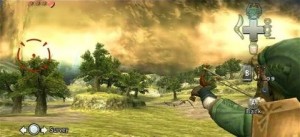 horse, to the Gorons and Zoras, to the Temple of Time. Link also gets a female sidekick, although she’s a distinct step up from Navi. Even the controls are largely similar, involving quick-button mapping, lock-on targeting and so on. There’s also a musical element involved, although it’s significantly less prominent than in OoT (or in Majora’s Mask, or in The Wind Waker, for that matter). Still, even with all the borrowing going on, Twilight Princess is my favourite Zelda game to date.
horse, to the Gorons and Zoras, to the Temple of Time. Link also gets a female sidekick, although she’s a distinct step up from Navi. Even the controls are largely similar, involving quick-button mapping, lock-on targeting and so on. There’s also a musical element involved, although it’s significantly less prominent than in OoT (or in Majora’s Mask, or in The Wind Waker, for that matter). Still, even with all the borrowing going on, Twilight Princess is my favourite Zelda game to date.
The first reason, shallow as it may sound, would be the graphics. I’m sure that even the most diehard OoT fans will agree that N64 graphics weren’t exactly of the highest quality, and that they made numerous NPCs look really ugly. I mean nightmare-fuel ugly. Not so here: Twilight Princess is, first and foremost, lovely to look at. It couldn’t hold a candle to some of its contemporaries on beefier consoles, but that’s not really 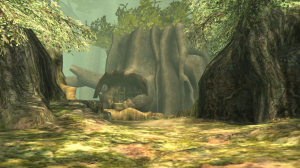 the point. To me, the Zelda series has always had a fairytale-like quality to it, and this game does it ample justice. Whether it be the quaint Ordon village, where Link resides, the lush forest which surrounds it, the green fields of Hyrule, the sweeping expanse of Lake Hylia or the grandiose architecture of Hyrule Castle, every environment is bright, warm (well, except Snowpeak) and alive, striking what I find to be exactly the right note for this kind of game. All these locales are populated with quirky, colourful characters who no longer look like they’re auditioning for
the point. To me, the Zelda series has always had a fairytale-like quality to it, and this game does it ample justice. Whether it be the quaint Ordon village, where Link resides, the lush forest which surrounds it, the green fields of Hyrule, the sweeping expanse of Lake Hylia or the grandiose architecture of Hyrule Castle, every environment is bright, warm (well, except Snowpeak) and alive, striking what I find to be exactly the right note for this kind of game. All these locales are populated with quirky, colourful characters who no longer look like they’re auditioning for 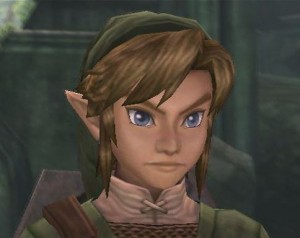 the latest Tim Burton film (well…mostly *edges slowly away from Fyer and Falbi*). Most importantly, the graphics greatly help in the expressiveness department, which is vital in making a silent protagonist relatable, and Link’s baby blues and sharp features have never looked so good. Especially since he spends the entire game as an adult, rather than switching between being 7 and 17, as he did in OoT.
the latest Tim Burton film (well…mostly *edges slowly away from Fyer and Falbi*). Most importantly, the graphics greatly help in the expressiveness department, which is vital in making a silent protagonist relatable, and Link’s baby blues and sharp features have never looked so good. Especially since he spends the entire game as an adult, rather than switching between being 7 and 17, as he did in OoT.
The second reason is the gameplay. While the basics are essentially a direct copy of OoT, there is one major innovation. According to the storyline, the kingdom of Hyrule becomes parasitized by the Twilight Realm, a dimension which usually exists in parallel to the ‘normal’ world, but suddenly begins to manifest directly into it, shadowy black monsters included. It appears as a golden glow with dark particles rising up from the 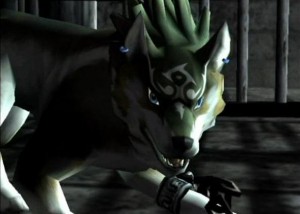 ground, and transforms Hyrule’s inhabitants into spirits. However, Link, who holds the Triforce of Courage, as he usually does in the series, reacts to it in quite a different way: he transforms into a large wolf. And while this feature unfortunately dwindles in importance as the game progresses, it nevertheless lends a welcome change of pace to several of the game’s sequences. Wolf Link may not be a genius swordsman or a master bowyer, but he’s fun and original to play as. Paradoxically enough, he is also instrumental in learning sword techniques: peppered around the world are stones with holes in them, which look like Gossip
ground, and transforms Hyrule’s inhabitants into spirits. However, Link, who holds the Triforce of Courage, as he usually does in the series, reacts to it in quite a different way: he transforms into a large wolf. And while this feature unfortunately dwindles in importance as the game progresses, it nevertheless lends a welcome change of pace to several of the game’s sequences. Wolf Link may not be a genius swordsman or a master bowyer, but he’s fun and original to play as. Paradoxically enough, he is also instrumental in learning sword techniques: peppered around the world are stones with holes in them, which look like Gossip 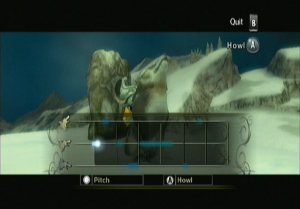 Stones from OoT and produce a melody when the wind blows through them. By howling along with the melody (there’s your musical element), Wolf Link can trigger sequences which allow vanilla Link to perfect his swordplay. Some of these techniques are particularly handy, by the way, lending an extra layer of sophistication to combat.To continue in the gameplay department, one of the main features of any Zelda game are the various gadgets Link picks up during his travels, such as a boomerang or bombs. While the selection available in this game is fairly run-of-the-mill, it does feature three highlights. Bomb arrows–which, as their name implies, can be created by attaching a bomb to an arrow–allow for long-range destruction without the iffy aim of simply throwing a bomb (they can still detonate in Link’s face if not fired promptly, however). The double clawshot turns Link into a Spiderman-wannabe and allows him to perform aerial stunts. It is acquired and abundantly used in the infamous City in the Sky dungeon, which I must
Stones from OoT and produce a melody when the wind blows through them. By howling along with the melody (there’s your musical element), Wolf Link can trigger sequences which allow vanilla Link to perfect his swordplay. Some of these techniques are particularly handy, by the way, lending an extra layer of sophistication to combat.To continue in the gameplay department, one of the main features of any Zelda game are the various gadgets Link picks up during his travels, such as a boomerang or bombs. While the selection available in this game is fairly run-of-the-mill, it does feature three highlights. Bomb arrows–which, as their name implies, can be created by attaching a bomb to an arrow–allow for long-range destruction without the iffy aim of simply throwing a bomb (they can still detonate in Link’s face if not fired promptly, however). The double clawshot turns Link into a Spiderman-wannabe and allows him to perform aerial stunts. It is acquired and abundantly used in the infamous City in the Sky dungeon, which I must 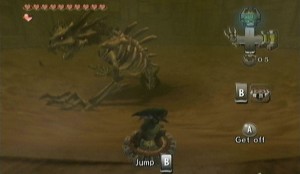 praise for its originality (especially the boss battle at the end), but also curse abundantly for its setting. I’m afraid of heights! Finally, you have the spinner, which is best described as a clockwork hoverboard. It can attach itself to grooves in walls, propelling Link along at high speeds, which makes the boss battle in the dungeon it’s acquired from a lot of fun.
praise for its originality (especially the boss battle at the end), but also curse abundantly for its setting. I’m afraid of heights! Finally, you have the spinner, which is best described as a clockwork hoverboard. It can attach itself to grooves in walls, propelling Link along at high speeds, which makes the boss battle in the dungeon it’s acquired from a lot of fun.
The third reason is the supporting cast. I’m sure Navi was created with the best intentions in mind, but “hey listen!” got infuriating after a while. Tatl, her successor in Majora’s Mask, did little to improve the score with her rudeness. This time around, Link 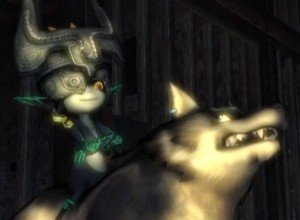 is (literally) saddled with Midna, a mischievous, imp-like inhabitant of the Twilight Realm who has a bone to pick with the game’s main antagonist, Zant. She finds him in his wolf form and proffers her help by riding on his back and using the decidedly strange properties of her hair (which can turn into a large hand…) to help him execute certain manoeuvres. When he is in Hylian form, she hides in his shadow and continues to supply guidance. Sounds like just another variation on the annoying-yet-lovable sidekick thus far, but Midna trumps her predecessors by dint of being a fully-fledged, sympathetic character and one of the main protagonists of the game, second
is (literally) saddled with Midna, a mischievous, imp-like inhabitant of the Twilight Realm who has a bone to pick with the game’s main antagonist, Zant. She finds him in his wolf form and proffers her help by riding on his back and using the decidedly strange properties of her hair (which can turn into a large hand…) to help him execute certain manoeuvres. When he is in Hylian form, she hides in his shadow and continues to supply guidance. Sounds like just another variation on the annoying-yet-lovable sidekick thus far, but Midna trumps her predecessors by dint of being a fully-fledged, sympathetic character and one of the main protagonists of the game, second  only to Link himself. Sure, Princess Zelda’s in there too, and she both offers and needs assistance as well, but she takes a definite backseat to the driving duo, the dynamics of which are one of the game’s main perks. Other than that, there’s also a handful of resistants to Zant’s rule who try their best to help Link, making him feel a bit more integrated than his ‘lone ranger’ persona in OoT. And I must also put a word in for the pair of yetis he runs into during his travels: the female one, aptly named Yeta, is all kinds of adorable. Even though she’s a crack snowboarder and may give you trouble in the minigame which involves challenging her and her husband Yeto for a piece of heart (hearts being the typical health-measuring unit in a Zelda game).
only to Link himself. Sure, Princess Zelda’s in there too, and she both offers and needs assistance as well, but she takes a definite backseat to the driving duo, the dynamics of which are one of the game’s main perks. Other than that, there’s also a handful of resistants to Zant’s rule who try their best to help Link, making him feel a bit more integrated than his ‘lone ranger’ persona in OoT. And I must also put a word in for the pair of yetis he runs into during his travels: the female one, aptly named Yeta, is all kinds of adorable. Even though she’s a crack snowboarder and may give you trouble in the minigame which involves challenging her and her husband Yeto for a piece of heart (hearts being the typical health-measuring unit in a Zelda game).
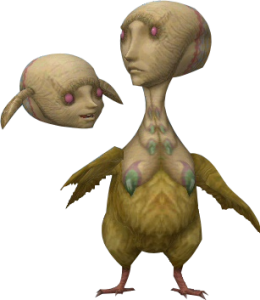 With all this in mind, the game does have its flaws. For one thing, the Wii and GameCube versions are mirror images of each other: as Link is traditionally left-handed, but the Wiimote isn’t, the developers solved the problem by flipping the entire game over (so what’s east on the GameCube is west on the Wii). I’d classify it as a nitpick, but Link purists may disagree. Moving along, strange creatures called Oocca have been introduced, their main gameplay purpose being to serve as quicksave points within dungeons, allowing Link to exit and come back in where he left off. I suppose this could be handy, if you found you needed to leave a dungeon for whatever reason, but I don’t think I’ve ever used them, so I find it a supremely superfluous feature. Not to mention that they look downright disturbing. There are still minigames, as mentioned earlier, usually for winning heart pieces, but if you were looking for a challenge, you may be disappointed. None of them reach the punishing heights of the archery challenges in OoT or Majora’s Mask. I actually thought that was a good thing, but your mileage may vary. However, if
With all this in mind, the game does have its flaws. For one thing, the Wii and GameCube versions are mirror images of each other: as Link is traditionally left-handed, but the Wiimote isn’t, the developers solved the problem by flipping the entire game over (so what’s east on the GameCube is west on the Wii). I’d classify it as a nitpick, but Link purists may disagree. Moving along, strange creatures called Oocca have been introduced, their main gameplay purpose being to serve as quicksave points within dungeons, allowing Link to exit and come back in where he left off. I suppose this could be handy, if you found you needed to leave a dungeon for whatever reason, but I don’t think I’ve ever used them, so I find it a supremely superfluous feature. Not to mention that they look downright disturbing. There are still minigames, as mentioned earlier, usually for winning heart pieces, but if you were looking for a challenge, you may be disappointed. None of them reach the punishing heights of the archery challenges in OoT or Majora’s Mask. I actually thought that was a good thing, but your mileage may vary. However, if 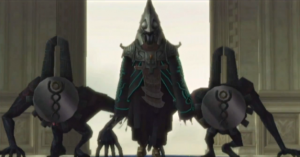 you were getting tired of the formulaic nature of the Zelda series, this won’t be the game to change your opinion, as it is not only the spiritual successor to OoT, but retains many traditional elements of the series as well. This notably applies to the villain department. While Zant is a successfully nefarious presence for the greater part of the game, his charisma takes a nosedive towards the end, and Ganondorf still turns out to be the big bad. That being said, you do get the satisfaction
you were getting tired of the formulaic nature of the Zelda series, this won’t be the game to change your opinion, as it is not only the spiritual successor to OoT, but retains many traditional elements of the series as well. This notably applies to the villain department. While Zant is a successfully nefarious presence for the greater part of the game, his charisma takes a nosedive towards the end, and Ganondorf still turns out to be the big bad. That being said, you do get the satisfaction 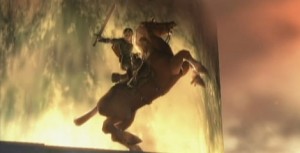 of a bona fide, one-on-one swordfight between him and Link. And you could put the repetitiveness in a different perspective. Twilight Princess could be perceived as the culminating point of the OoT formula in the series. That’s certainly what it felt like to me.
of a bona fide, one-on-one swordfight between him and Link. And you could put the repetitiveness in a different perspective. Twilight Princess could be perceived as the culminating point of the OoT formula in the series. That’s certainly what it felt like to me.
